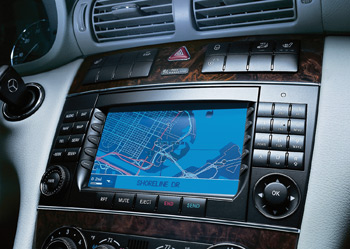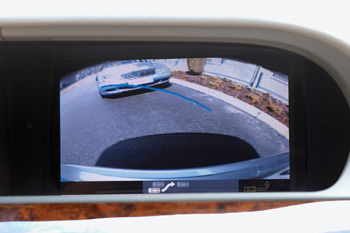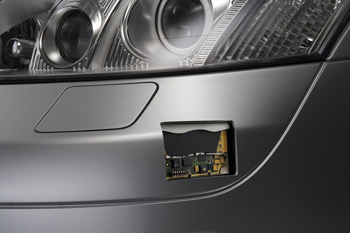 Modules are taking over the automotive world. The little electronic black boxes that were once limited to powertrain functions are now running almost every system on today’s vehicles. The automotive microcontroller (MCU) market is predicted to be a $6 billion a year business by 2012. That’s a lot of modules.
Modules are taking over the automotive world. The little electronic black boxes that were once limited to powertrain functions are now running almost every system on today’s vehicles. The automotive microcontroller (MCU) market is predicted to be a $6 billion a year business by 2012. That’s a lot of modules.
The average new car today has up to 80 or more modules that control more than 1,000 different functions — everything from powertrain management, anti-lock brakes, stability control, electronic suspension and airbag deployment to power windows, power seats, climate control, infotainment and navigation. According to industry estimates, the software in all of these different modules contains about 35 million lines of code.

Some of the fastest growing module applications today are driver assistance systems. These include such features as navigation, adaptive cruise control, parking assist, rear view cameras, night vision, obstacle detection/collision warning systems, blind spot detection, active lighting and automatic braking. Though some of these new features are still only available on high-end, luxury models, the price of the technology is coming down, allowing more and more electronic content to be offered in mid-range and even some entry-level models.

The demand for driver assistance systems is exploding, with an annual growth rate of around 14% (in spite of a down market). The usage of LCD displays and camera sensors in new vehicles is expected to jump 40% or more over the next five years.
BMW says that electronics alone account for about 40-45% of the cost of their 7-Series cars. That’s a lot of electronics in a car that typically sells in the $74,000 to $84,000 range.
So what does all this mean for aftermarket parts suppliers and auto repair shops? It means a proliferation of module replacement opportunities, some major auto repair challenges for technicians, and some big repair bills for motorists down the road.

Some industry sources say that nearly 1/3 of all new car warranty claims today are directly or indirectly software-related. This includes module miscommunications, malfunctions, bugs and failures that affect the mechanical systems they control or result in driveability, emissions, performance or system functionality issues.
Most motorists could care less what a repair costs as long as the repair is covered under a warranty because they pay nothing or only a small out-of-pocket deductible. But once a vehicle comes out of warranty, repair bills can skyrocket. Many modules cost hundreds of dollars to replace, and some as much as several thousand dollars!
Electronics are great when everything is working correctly. But if the software that controls a module is buggy, or interference scrambles a module’s input/output signals, or there’s noise on the CAN bus that messes up communications, or a chip inside a module fails, it can cause a loss of control over certain functions, upset the operation of other systems that share data, or even cause a system-wide crash. Modules don’t have moving parts to wear out, but they can be damaged by heat, vibration, corrosion and voltage overloads. Electronic components also degrade with time and usage, and can fail abruptly with no warning whatsoever.
As the current generation of vehicles age and come out of warranty, the burden of diagnosing and repairing module-related problems will fall on independent repair shop technicians. That isn’t a problem provided technicians get the training they need to keep up with the latest technology. They also have to keep their scan tools current with the latest OEM software updates. And they have to know how to reflash modules if a reflash is needed to correct a certain problem (and where to get the latest reflash updates, and how to download and install the updates in the vehicle).
Another issue is parts availability (or a lack thereof). The proliferation of modules has created hundreds of part numbers that are mostly “dealer only” parts. Many modules are not currently available from aftermarket suppliers, and may never be available for a variety of reasons (proprietary software/hardware, the high cost of reverse engineering replacement modules, applications that are too low volume to produce and stock parts for profitably, etc.). Consequently, new car dealers are enjoying and will continue to enjoy a monopoly on many types of replacement modules — which means higher replacement costs for vehicle owners.
As a rule, most vehicle manufacturers maintain an inventory of replacement parts for a period of about 10 years after a vehicle is produced. After that, the parts are discontinued. OEM suppliers typically make a certain quantity of extra parts for service in addition to those needed for the factory assembly line. They may continue to make replacement parts for the vehicle for a number of years after the vehicle has gone out of production, depending on demand. But in many cases, no additional replacement parts are made after the initial run has been produced. That’s often the case with electronic modules that may only be used in a few model applications, or limited to a certain model year.
So, if a module in an older vehicle needs to be replaced, and that module is no longer available through the new car dealer parts department, and is not available in the aftermarket, the only remaining source would be a used part from a salvage yard. And if you can’t find a good used part? You can’t fix the car.
That’s what they call “Planned Obsolescence.”












